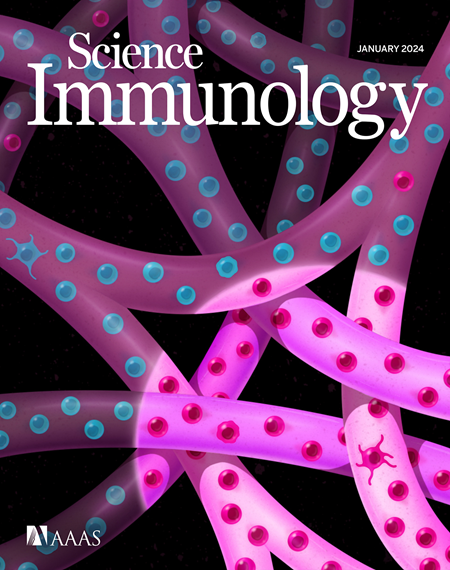Orientation-dependent CD45 inhibition with viral and engineered ligands
IF 17.6
1区 医学
Q1 IMMUNOLOGY
引用次数: 0
Abstract
CD45 is a cell surface phosphatase that shapes the T cell receptor signaling threshold but does not have a known ligand. A family of adenovirus proteins, including E3/49K, exploits CD45 to evade immunity by binding to the extracellular domain of CD45, resulting in the suppression of T cell signaling. We determined the cryo-EM structure of this complex and found that the E3/49K protein is composed of three immunoglobulin domains assembled as “beads on a string” that compel CD45 into a closely abutted dimer by cross-linking the CD45 D3 domain, leading to steric inhibition of its intracellular phosphatase activity. Inspired by the E3/49K mechanism, we engineered CD45 surrogate ligands that can fine-tune T cell activation by dimerizing CD45 into different orientations and proximities. The adenovirus E3/49K protein has taught us that, despite a lack of a known ligand, CD45 activity can be modulated by extracellular dimerizing ligands that perturb its phosphatase activity and alter T cell responses.
利用病毒配体和工程配体抑制定向依赖性 CD45
CD45 是一种细胞表面磷酸酶,可形成 T 细胞受体信号阈值,但没有已知的配体。包括 E3/49K 在内的一系列腺病毒蛋白通过与 CD45 的细胞外结构域结合,抑制 T 细胞信号传导,从而利用 CD45 逃避免疫。我们测定了这一复合物的低温电子显微镜结构,发现 E3/49K 蛋白由三个免疫球蛋白结构域组成,它们像 "串珠 "一样组装在一起,通过交联 CD45 D3 结构域迫使 CD45 变成一个紧密相连的二聚体,从而导致其细胞内磷酸酶活性受到立体抑制。受 E3/49K 机制的启发,我们设计出了 CD45 替代配体,它们可以通过将 CD45 二聚为不同的方向和接近度来微调 T 细胞的活化。腺病毒 E3/49K 蛋白告诉我们,尽管缺乏已知的配体,但 CD45 的活性可以通过细胞外二聚配体来调节,从而扰乱其磷酸酶活性并改变 T 细胞的反应。
本文章由计算机程序翻译,如有差异,请以英文原文为准。
求助全文
约1分钟内获得全文
求助全文
来源期刊

Science Immunology
Immunology and Microbiology-Immunology
CiteScore
32.90
自引率
2.00%
发文量
183
期刊介绍:
Science Immunology is a peer-reviewed journal that publishes original research articles in the field of immunology. The journal encourages the submission of research findings from all areas of immunology, including studies on innate and adaptive immunity, immune cell development and differentiation, immunogenomics, systems immunology, structural immunology, antigen presentation, immunometabolism, and mucosal immunology. Additionally, the journal covers research on immune contributions to health and disease, such as host defense, inflammation, cancer immunology, autoimmunity, allergy, transplantation, and immunodeficiency. Science Immunology maintains the same high-quality standard as other journals in the Science family and aims to facilitate understanding of the immune system by showcasing innovative advances in immunology research from all organisms and model systems, including humans.
 求助内容:
求助内容: 应助结果提醒方式:
应助结果提醒方式:


